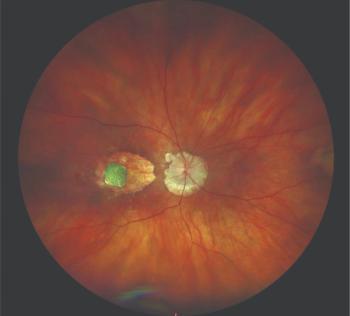
Corneal epithelial barrier function studied in eyes receiving fluoroquinolones
Fort Lauderdale, FL- In a preliminary mouse model study of corneal epithelial permeability and barrier function, several differences were found be- tween gatifloxacin ophthalmic solution 0.3% (Zymar, Allergan) and moxifloxacin ophthalmic solu- tion 0.5% (Vigamox, Alcon) but the significance of these findings is unclear, ac- cording to Stephen C. Pflugfelder, MD, who presented a poster on this study at the annual meeting of the Association for Research in Vision and Ophthalmology
This study was performed to learn more about the potential toxicity on surface healing and epithelial healing of gatifloxacin and moxifloxacin, fourth-generation fluoroquinolones that have been recently introduced to the ophthalmic community, Dr. Pflugfelder said.
"There were differences between the two antibiotics, with one showing no change from the baseline and one showing a change," Dr. Pflugfelder said, explaining that these results could be interpreted to indicate that gatifloxacin was protective because it did not cause any adverse effects in the dry eye environment. "We did see changes with moxifloxacin, but we don't know whether those are greater than we would find with just dry eye treatment."
Permeability was measured before treat-ment and at 2 and 5 days.
"We found that with the gatifloxacin-treated mice there was a slight increase in fluorescein permeability at day 2, but it didn't reach statistical significance. By day 5 it was back down to the baseline level," said Dr. Pflugfelder, professor, Ocular Surface Center, Ophthalmology, Baylor College of Medicine, Houston.
"With moxifloxacin there was a progressive increase in permeability over the 5-day period," he added. "By day 5 it was significantly different from the baseline and from the gatifloxacin-treated mice at 5 days."
Gatifloxacin caused significantly less disruption of corneal epithelial barrier function than did moxifloxacin, he said. The investigative team used scanning laser confocal microscopy in whole-mount corneas to evaluate expression of the protein ZO-1, which is associated with the tight junction. These tight junctions between corneal epithelial cells are essential for barrier function and normal homeostasis of the ocular surface.
Response to staining Corneas were immunostained for ZO-1, and the nuclei of epithelial cells were counterstained with propridium iodide. In untreated eyes, this staining produced an even, honeycomb pattern. In the gatifloxacin-treated eyes, a normal pattern of ZO-1 immunoreactivity was noted on days 2 and 5. The moxifloxacin-treated eyes showed a pattern that suggested a cellular stress or toxic response, Dr. Pflugfelder noted.
Dr. Pflugfelder and his colleagues used a model for inducing dry eye in mice in which subcutaneous injections of 0.25 mg scopolamine were administered four times a day, and the animals were exposed to a draft and low humidity 16 hours a day for up to 5 days. Both eyes of each mouse were treated with 1 ml of either gatifloxacin or moxifloxacin four times daily. Six mice were treated in each group, and a separate group was used as the control.
Dr. Pflugfelder noted that differences between the two antibiotics, such as their concentrations and preservatives, may be important for eyes with decreased tear production and clearance because these eyes are more susceptible than normal eyes to epithelial toxicity from topically applied medications and their preservatives.
The apparently greater toxicity of moxifloxacin noted in this study may seem counterintuitive to what is known about the toxicity of benzalkonium chloride (BAK), a preservative used in some ophthalmic antibiotics, Dr. Pflugfelder said. Moxifloxacin does not contain a preservative in its formulation and gatifloxacin is preserved with 0.005% BAK, he said.
According to Dr. Pflugfelder, the toxicity observed with moxifloxacin may be due to the inherent qualities of the molecule.OT
Newsletter
Don’t miss out—get Ophthalmology Times updates on the latest clinical advancements and expert interviews, straight to your inbox.





